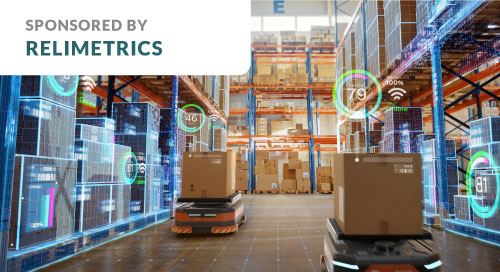Fill form to unlock content
Error - something went wrong!
Stay up to date with the latest IoT and network edge news.
Subscribed.
AI Boosts Supply Chain Efficiency and Profits

There is a plethora of possibilities for things to go wrong in logistics operations and supply chains across industries. Take, for example, the energy industry. According to a study from the National Renewable Energy Laboratory, blade failure is the most common breakdown in wind turbines. An average of 40 events per turbine happen each year, causing about an hour of downtime per event, and resulting in costly repairs and lost revenue.
So how do you minimize the risk and maximize profits?
Advances in artificial intelligence can help companies identify where things are going wrong as products are handed off across the supply chain—lessening the chance of failure.
A good example is renewable energy leader Siemens Gamesa, which engaged Relimetrics, an AI-boosted machine vision solutions provider, to inspect its wind turbine blades before they are released to customers.
Using Relimetrics’ AI-based quality automation and non-destructive inspection digitization platform ReliVision, Siemens Gamesa was able to automate the inspection of phased array ultrasonic data, and assess the condition of blades before they’re placed in the field.
“The main challenge of our typical customer is to digitize inspections—which is time-consuming and prone to errors—and improve traceability across their supply chain,” says Relimetrics Founder and CEO Kemal Levi. “With ReliVision, our customers can rapidly implement AI-based machine vision algorithms on their shop floor without writing a single line of code. They can share trained models across inspection points and leverage existing camera hardware irrespective of image modality.”
Gaining Tracing Quality Across the Supply Chain
Traceability of product quality is the most essential bit of information with the supply chain, Levi explains.
“If you think about the supply chain, information is flowing from one location to another at a holistic level,” he says. “There are many parties involved, and it is important for anyone to track quality information at different points along the way.”
Tracing the quality status of parts or products from a multitude of suppliers to a manufacturer is one of those points. As parts move along the supply chain, quality automation helps identify anomalies before they get to the customer and risk downtime.
“For OEMs (Original Equipment Manufacturers), it is really important to be able to trace quality across its suppliers and to run data analytics to see which one is actually performing better,” says Levi. “Then they can weed out those vendors that are not up to par.”
As parts move along the #SupplyChain, quality #automation helps identify anomalies before they get to the customer and risk downtime. @relimetrics via @insightdottech
Improving the Bottom Line with Quality Automation
As manufacturers ship products to their customers, they must identify issues with outbound transportation and logistics.
“A magnifying lens looking at different points of the supply chain will give better visibility to an OEM,” says Levi. “At the end of the day, this is an effort to improve margins. And in the case of the energy sector, margins are razor thin as integrators put pricing pressure on suppliers.”
Maximizing the number of items getting to the end of the manufacturing line that meet the required quality standards has a direct impact on the bottom line. Similarly, in the electronics and automotive sectors, the pressure on prices continues throughout the supply chain. As OEMs put pressure on suppliers to reduce prices to maintain their margins, every item that can be produced with quality—and not be subject to scrap and rework pre-shipment or warranty claims post-shipment—will benefit the top-line revenue, bottom-line costs, and overall profit margins.
Traditionally, the supply chain has relied on manual inspections and sorting. But this process can be labor-intensive and prone to error, adding costs to the loss. Today, AI-driven quality automation tools like ReliVision can be deployed without requiring any programming skills or prior machine-learning knowledge, offering access to real-time information that can improve efficiency and visibility.
An industrial-grade image and video analytics solution, ReliVision can integrate with any industrial-grade camera hardware and NDT setup to analyze data streams of inspected parts or products as they travel through the supply chain. The data feed is streamed to a connected IT system that leverages Intel® processors and Intel® Movidius Vision Processing Units, digitizing inspection of the product.
Vision Processing Units, digitizing inspection of the product.
If an anomaly is detected, an alert is sent to the operator to pull off the faulty part or product, or fix the issue before shipment.
Integrating Supply Chain Data with ERP Systems
ReliVision also integrates with enterprise resource planning (ERP) systems. Correlation of acquired data across the product life cycle—from manufacturing to sales to service—enables continuous business intelligence.
“ERP has the supply chain management component, as well as manufacturing information, project management information, sales and marketing information, service management, business intelligence, and big-data analytics,” says Levi. “The advantage of being able to connect to ERP is that you can derive additional insights to make better supply chain decisions.”
Automation throughout the supply chain is critical. “These are the people who can rapidly make decisions that can save thousands, if not millions, of dollars and improve margins for the company,” says Levi. “In the case of a recall, we are able to document the quality of every product when it actually left the factory floor.”
“At the holistic level, quality automation is about risk analytics to help ensure a good customer experience while lowering operational costs,” he continues. “In the end, a company that can trace quality in real time and do a better assessment on where quality issues originate, can ultimately boost profitability.”